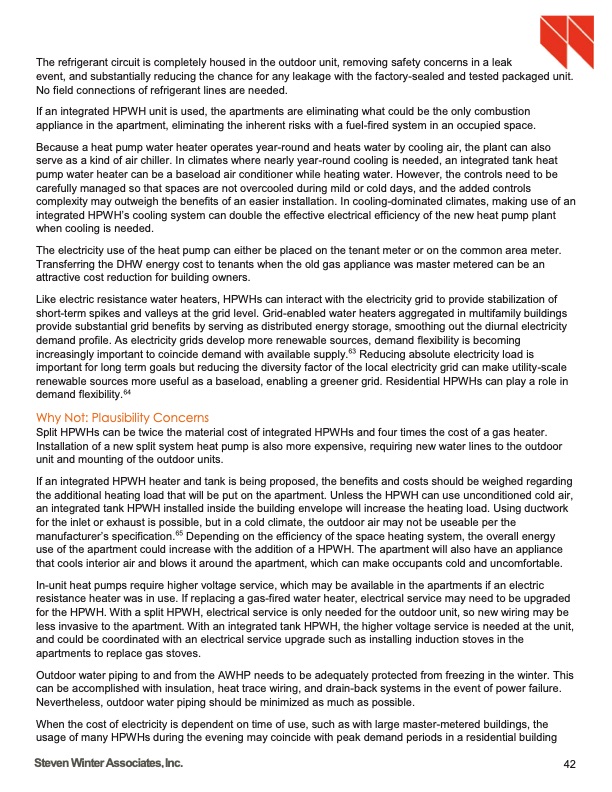
PDF Publication Title:
Text from PDF Page: 042
The refrigerant circuit is completely housed in the outdoor unit, removing safety concerns in a leak event, and substantially reducing the chance for any leakage with the factory-sealed and tested packaged unit. No field connections of refrigerant lines are needed. If an integrated HPWH unit is used, the apartments are eliminating what could be the only combustion appliance in the apartment, eliminating the inherent risks with a fuel-fired system in an occupied space. Because a heat pump water heater operates year-round and heats water by cooling air, the plant can also serve as a kind of air chiller. In climates where nearly year-round cooling is needed, an integrated tank heat pump water heater can be a baseload air conditioner while heating water. However, the controls need to be carefully managed so that spaces are not overcooled during mild or cold days, and the added controls complexity may outweigh the benefits of an easier installation. In cooling-dominated climates, making use of an integrated HPWH’s cooling system can double the effective electrical efficiency of the new heat pump plant when cooling is needed. The electricity use of the heat pump can either be placed on the tenant meter or on the common area meter. Transferring the DHW energy cost to tenants when the old gas appliance was master metered can be an attractive cost reduction for building owners. Like electric resistance water heaters, HPWHs can interact with the electricity grid to provide stabilization of short-term spikes and valleys at the grid level. Grid-enabled water heaters aggregated in multifamily buildings provide substantial grid benefits by serving as distributed energy storage, smoothing out the diurnal electricity demand profile. As electricity grids develop more renewable sources, demand flexibility is becoming increasingly important to coincide demand with available supply.63 Reducing absolute electricity load is important for long term goals but reducing the diversity factor of the local electricity grid can make utility-scale renewable sources more useful as a baseload, enabling a greener grid. Residential HPWHs can play a role in demand flexibility.64 Why Not: Plausibility Concerns Split HPWHs can be twice the material cost of integrated HPWHs and four times the cost of a gas heater. Installation of a new split system heat pump is also more expensive, requiring new water lines to the outdoor unit and mounting of the outdoor units. If an integrated HPWH heater and tank is being proposed, the benefits and costs should be weighed regarding the additional heating load that will be put on the apartment. Unless the HPWH can use unconditioned cold air, an integrated tank HPWH installed inside the building envelope will increase the heating load. Using ductwork for the inlet or exhaust is possible, but in a cold climate, the outdoor air may not be useable per the manufacturer’s specification.65 Depending on the efficiency of the space heating system, the overall energy use of the apartment could increase with the addition of a HPWH. The apartment will also have an appliance that cools interior air and blows it around the apartment, which can make occupants cold and uncomfortable. In-unit heat pumps require higher voltage service, which may be available in the apartments if an electric resistance heater was in use. If replacing a gas-fired water heater, electrical service may need to be upgraded for the HPWH. With a split HPWH, electrical service is only needed for the outdoor unit, so new wiring may be less invasive to the apartment. With an integrated tank HPWH, the higher voltage service is needed at the unit, and could be coordinated with an electrical service upgrade such as installing induction stoves in the apartments to replace gas stoves. Outdoor water piping to and from the AWHP needs to be adequately protected from freezing in the winter. This can be accomplished with insulation, heat trace wiring, and drain-back systems in the event of power failure. Nevertheless, outdoor water piping should be minimized as much as possible. When the cost of electricity is dependent on time of use, such as with large master-metered buildings, the usage of many HPWHs during the evening may coincide with peak demand periods in a residential building Steven Winter Associates,Inc. 42PDF Image | HEAT PUMP RETROFIT STRATEGIES FOR MULTIFAMILY BUILDINGS

PDF Search Title:
HEAT PUMP RETROFIT STRATEGIES FOR MULTIFAMILY BUILDINGSOriginal File Name Searched:
heat-pump-retrofit-strategies-report-05082019.pdfDIY PDF Search: Google It | Yahoo | Bing
CO2 Organic Rankine Cycle Experimenter Platform The supercritical CO2 phase change system is both a heat pump and organic rankine cycle which can be used for those purposes and as a supercritical extractor for advanced subcritical and supercritical extraction technology. Uses include producing nanoparticles, precious metal CO2 extraction, lithium battery recycling, and other applications... More Info
Heat Pumps CO2 ORC Heat Pump System Platform More Info
| CONTACT TEL: 608-238-6001 Email: greg@infinityturbine.com | RSS | AMP |